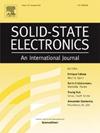重复 UIS 应力期间 1.2 kV 平面 SiC MOSFET 的阈值电压演变
IF 1.4
4区 物理与天体物理
Q3 ENGINEERING, ELECTRICAL & ELECTRONIC
引用次数: 0
摘要
本文对1.2 kv平面碳化硅(SiC) mosfet进行了重复非箝位电感开关(UIS)应力。施加了不同的关断栅极电压偏置(Vgs-off = 0 V/−5 V/−10 V)。观察了导通电阻(Ron)和阈值电压(Vth)在不同条件下的变化。在−5 V和−10 V的电压关断条件下,Ron增加,Vth负移。进行了失效分析,探讨了Ron的降解机理。通过扫描电子束观测,验证了应力作用下芯片上表面铝的熔化现象。对于Vth位移,将施加在器件上的重复UIS应力分析为高温反向偏压(HTRB)应力和高温栅偏压(HTGB)应力的组合。为了辅助机理分析,对美国雪崩过程进行了TCAD模拟。当施加负vgs关断时,沟道区域进入累积状态,电场指向栅极氧化物。这有利于热孔注入栅极氧化物,导致氧化物正电荷密度显著增加。随着负Vgs-off偏置幅度的增大,栅极氧化物中的电场应力和沟道区域的空穴密度加剧,导致Vth偏移更加明显。本文章由计算机程序翻译,如有差异,请以英文原文为准。
Evolution of threshold voltage in 1.2-kV planar SiC MOSFETs during repetitive UIS stressing
In this paper, repetitive unclamped inductive switching (UIS) stressing was conducted on 1.2-kV planar silicon carbide (SiC) MOSFETs. Different off-state gate voltage biases (Vgs-off = 0 V/−5 V/−10 V) were applied. The evolution of on-resistance (Ron) and threshold voltage (Vth) in different conditions has been observed. It was found that Ron was increased and Vth was negatively shifted for −5 V and −10 V Vgs-off conditions. Failure analysis was conducted to investigate the Ron degradation mechanism. Aluminum (Al) melting on chip upper surface occurred during UIS stressing, which was verified by scanned-electron-beam observation. Regarding Vth shift, the repetitive UIS stressing applied on the devices was analyzed as a combination of high-temperature reverse bias (HTRB) stress and high-temperature gate bias (HTGB) stress. To aid the mechanism analysis, TCAD simulations of the UIS avalanche process were conducted. When negative Vgs-off was applied, the channel region entered an accumulated state, and the electric field was directed toward the gate oxide. This facilitated hot hole injection into the gate oxide, leading to a significant increase in positive oxide charge density. As the magnitude of the negative Vgs-off bias increased, the electric field stress in the gate oxide and hole density in the channel region were aggravated, resulting in a more pronounced Vth shift.
求助全文
通过发布文献求助,成功后即可免费获取论文全文。
去求助
来源期刊

Solid-state Electronics
物理-工程:电子与电气
CiteScore
3.00
自引率
5.90%
发文量
212
审稿时长
3 months
期刊介绍:
It is the aim of this journal to bring together in one publication outstanding papers reporting new and original work in the following areas: (1) applications of solid-state physics and technology to electronics and optoelectronics, including theory and device design; (2) optical, electrical, morphological characterization techniques and parameter extraction of devices; (3) fabrication of semiconductor devices, and also device-related materials growth, measurement and evaluation; (4) the physics and modeling of submicron and nanoscale microelectronic and optoelectronic devices, including processing, measurement, and performance evaluation; (5) applications of numerical methods to the modeling and simulation of solid-state devices and processes; and (6) nanoscale electronic and optoelectronic devices, photovoltaics, sensors, and MEMS based on semiconductor and alternative electronic materials; (7) synthesis and electrooptical properties of materials for novel devices.
 求助内容:
求助内容: 应助结果提醒方式:
应助结果提醒方式:


